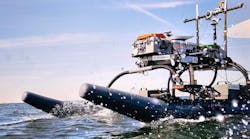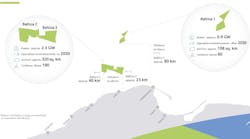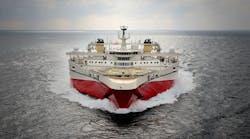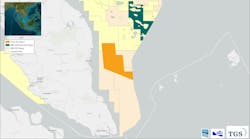Until recently, subsalt drilling was considered risky by all but the most specialized companies. Prospect ident-ification from seismic imaging below the salt masses was problematic. That meant no one could be sure they found a pay zone. Drilling conditions were difficult in supra-salt, salt, and subsalt conditions.
However, with advancements in 3D seismic and synthetics-based mud, subsalt drilling is now being revisited. Triton Engineering Services, a subsidiary of Noble Drilling, claims the firm is now confident in subsalt capabilities, such that the wells can be drilled on a turnkey basis.
About 40 miles off Fourchon, Louisiana, in Grand Isle Block 106, oil and gas producer BHP had a subsalt prospect named Viper. Prev-iously, Triton drilled two wells on prospects that flanked the salt feature dominating Viper, so BHP opened discussions with the turnkey company.
Triton received permission from the operators of those wells to share well data and pore pressure information for the purpose of discussing well planning with BHP. This relationship eventually led to Triton producing a proposal to drill the Viper prospect on a turnkey basis.
Casing setting
Successful drilling through a salt mass requires extensive investigation prior to designing the drilling program. It is particularly important that the casing string match the anticipated top and base of the salt. The drilling objective is to isolate the salt from the formations above, and to have the option of casing off any rubble or shear zones immediately below the salt. Pore pressure analysis, 3D seismic, and offset data all help the driller determine how many casing strings will be needed and where they should be placed.
In addition, to the two supra-salt wells drilled by Triton, BHP analyzed subsalt wells drilled by Anadarko Petroleum, on a prospect similar to Viper about seven miles away. This data helped in evaluating the requirements of the Viper drilling program.
Drilling subsalt is essentially a balancing act, according to David Mannon, Vice President and General Manager of Triton, between the expense of setting additional strings of casing and the requirement that the salt zone be isolated. When Triton evaluates a potential turnkey project, Mannon said there are three criteria that need to be achieved prior to submitting a bid; identifying the risk, quantifying the risk, and managing the risk. Once all of these are satisfied, the firm says it is confident the drilling program can be carried out for what was bid.
Basal shear zone
Subsalt drilling is tricky in a number of ways. Structure and stratigraphy are difficult to interpret from seismic. Salt has no inherent strength and tends to be mobile in response to differential pressures. Salt movement over geological time can produce hydrocarbon traps, but the motion of salt through sediments can also cause surrounding rock to fail.
The failed zones through which salt has migrated have some characteristics of rubble. The material has no strength, the rock fabric having been destroyed by the salt movement. These failed zones tend to be located below salt masses, hence the term basal shear zones (rubble zones). Lost circulation is a possible drilling problem as is potential wellbore instability. Finally, there is always a challenge in negotiating pressure transitions above salt masses.
BHP's initial requirement was a well design that could be drill-stem tested and subsequently suspended for re-entry as a future producer. This requirement placed constraints on the minimum acceptable hole size at TD and enforced a relatively inefficient well design. After discussion with BHP's partners, the testing and re-entry requirements were eliminated, allowing a more cost-efficient well design.
The original BHP casing program, which had a total of five casing strings supra-salt, was reduced to four strings supra-salt, with the possibility of a contingency string. Extensive research and analysis of available offset and pore pressure information gave Triton confidence that the well could be successfully drilled with a maximum of four casing strings supra salt. Triton researched the drilling program to its satisfaction, and was confident enough to convince BHP of the program's merit. Both BHP and Triton considered the possibility that a drilling liner might be necessary below the basal shear zone and both well programs allowed for that contingency.
Penetration rates
Viper well No. 1 was spudded in March, 2000 and required 56 days to drill and evaluate. Aside from the difficulty in drilling supra-salt and subsalt sections, drilling through the salt itself has traditionally been a slow and difficult process. One of the reasons operators shy away from drilling salt wells in the Gulf of Mexico (let alone drilling turnkey) is that the penetration rates can be unpredictable and such drilling is hard on the rig and equipment.
Mannon said this is no longer the problem it once was. In the past, drillers penetrated salt with conventional roller cone bits and salt-saturated mud systems. This led to slow penetration, drilling string failures, vibration, and directional problems. The new approach is to use PDC drill bits in conjunction with synthetic-based mud systems.
These newly formulated muds are more expensive. PDC bits are substantially more expensive relative to roller-conebits, adding to the project's day rate. Ron Brooks, Drilling Engineer with Triton, said the overall savings in time offsets these costs.
In general, Mannon said, Triton has learned over the course of drilling almost 400 wells in the US Gulf of Mexico, that paying more up front is the better way to go. Having better equipment means fewer problems. While the expense related to this equipment can be accounted for easily, it is difficult to predict the expense of an unanticipated problem.
Using the synthetic based mud and a PDC bit, Brooks said Triton was able to make good penetration rates through 7,000 ft of salt in the well. Throughout the program, rates of penetration were optimized using a Noble Drill Smart System (patented). While estimates of the rubble zone varied from 1,000 ft to as little as 500 ft., BHP and Triton's estimation was correct. Mannon said there was no need to use the optional drilling liner, since the intermediate casing was set through the basal zone and Triton's pore-pressure assessment was accurate.
Casing points
One of the reason's Triton was able to turnkey this subsalt well was the company's use of a casing program that would get through the salt zone without the need for contingency strings or liners. Mannon said this is the result of research and front-end engineering.
The 3D seismic over the prospect had indicated that the salt zone would run from approximately 6,580 ft below the mud line to 13,650 ft BML. According to Brooks, the casing points in this 19,300-ft well were 36-in. at 861 ft, 26-in. at 1,309 ft, 20-in. at 3,983 ft, 13 5/8-in. into the salt zone at 6,680 ft., 9 7/8-in. below the "rubble zone" at 15,846 ft for a TD at 19,204 ft.






